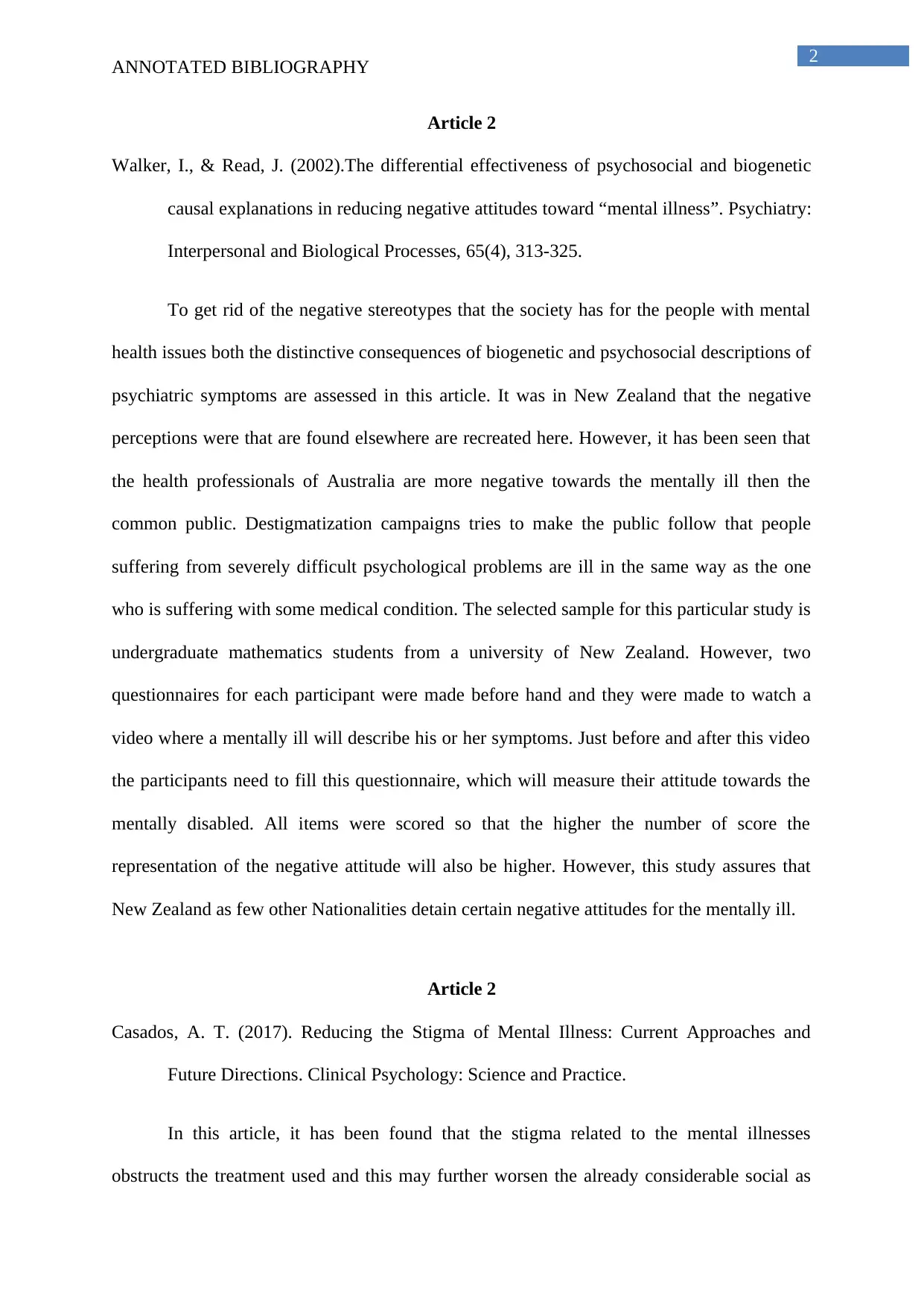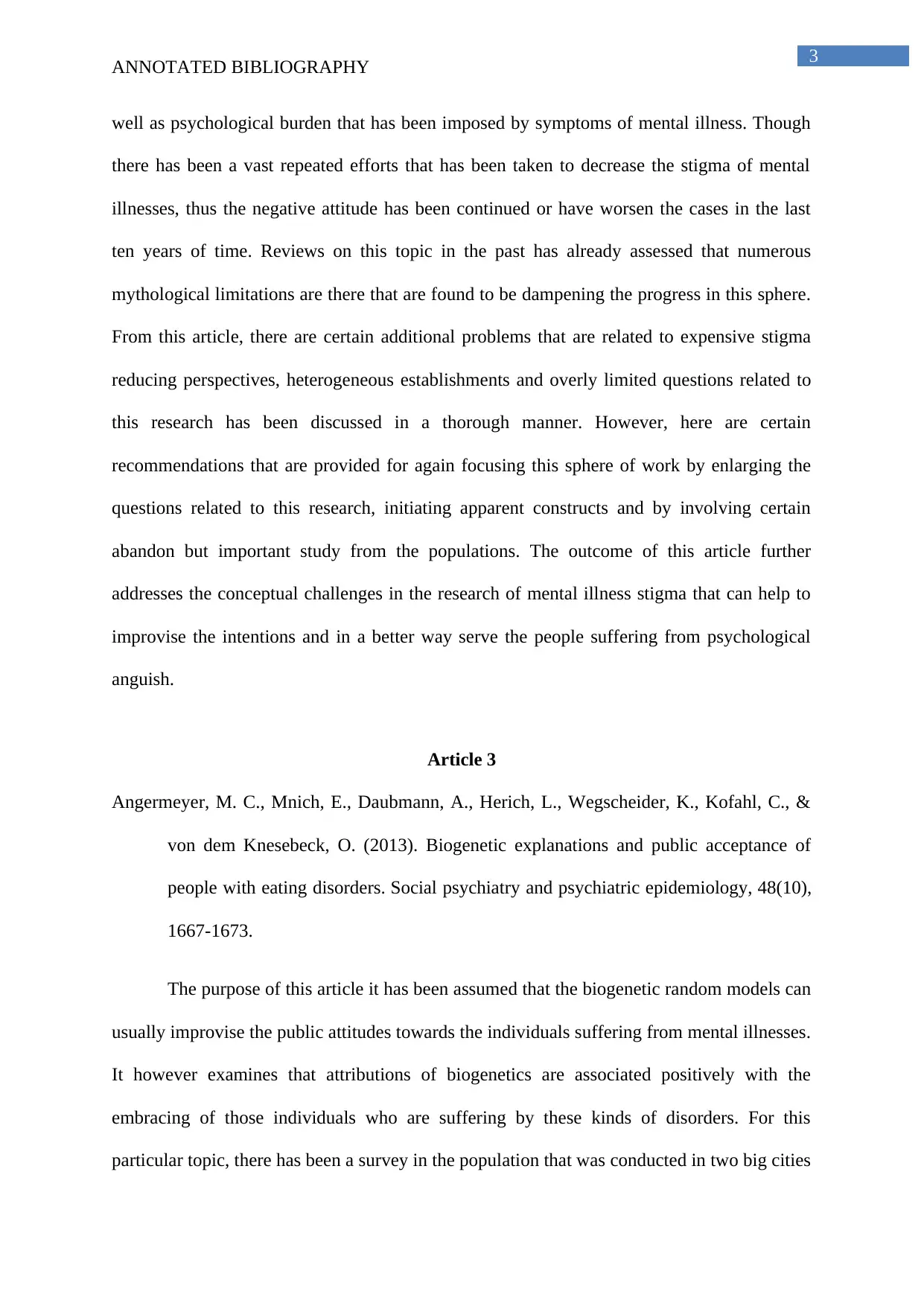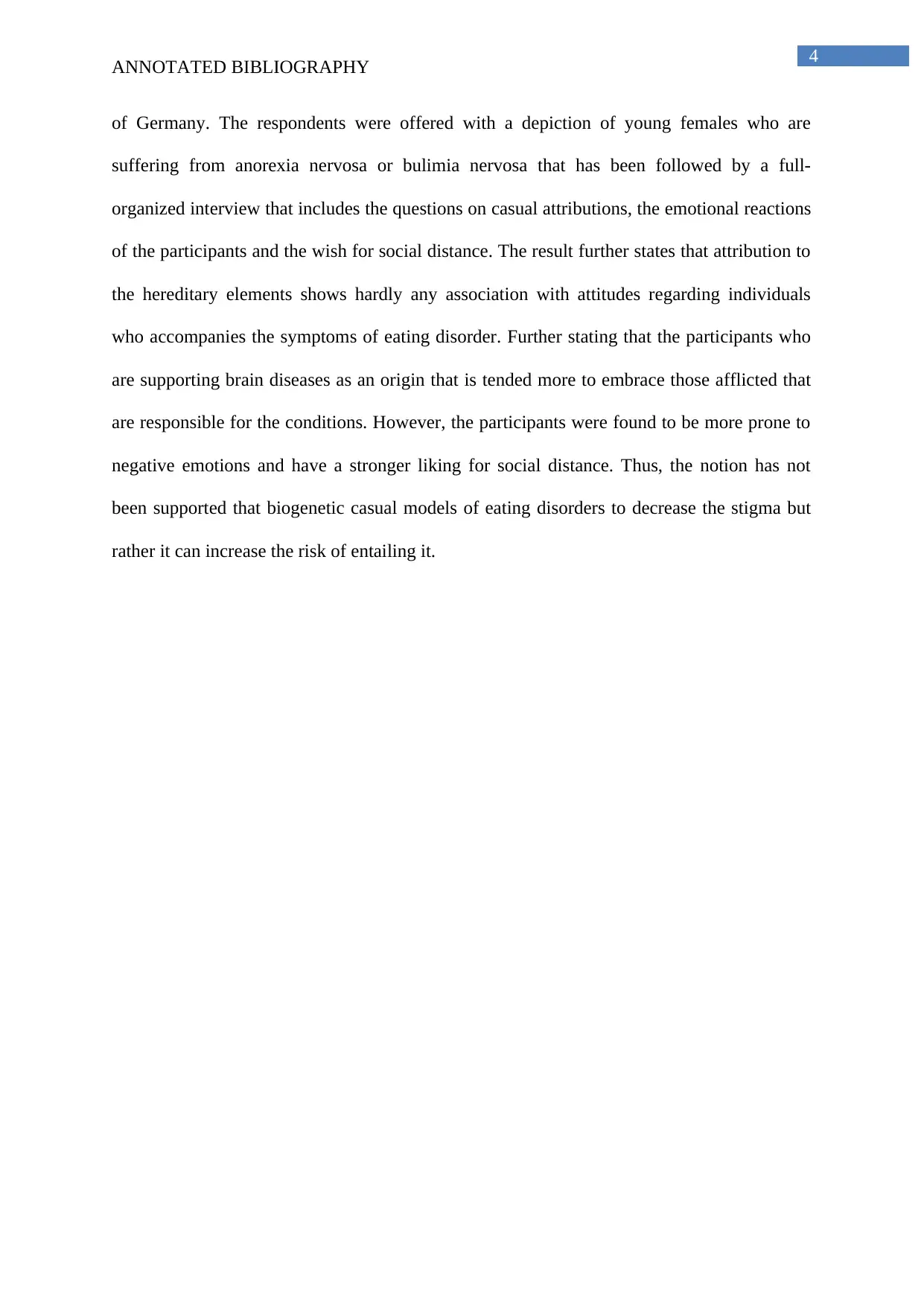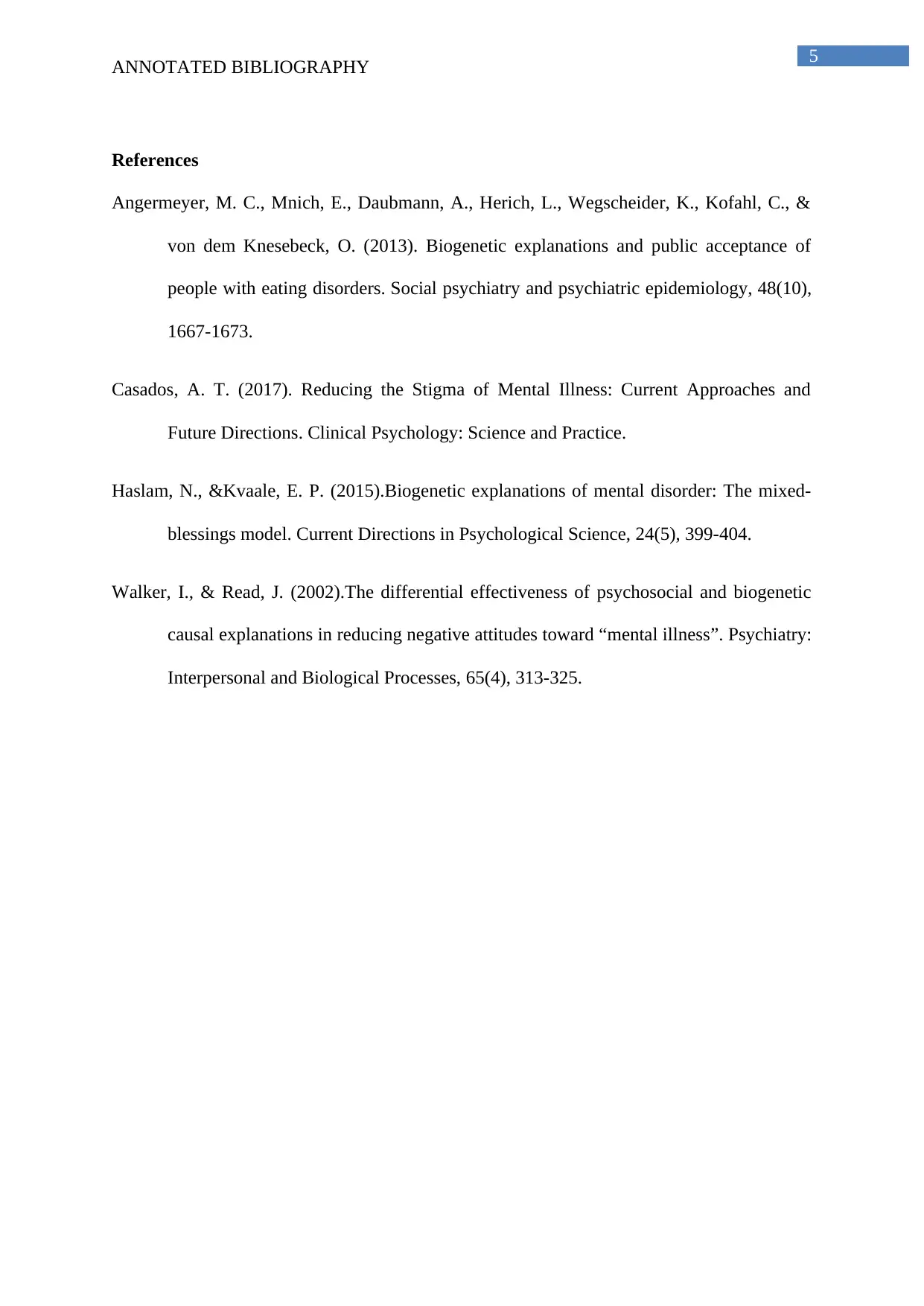Mental Illness Stigma: Biogenetic Explanations Annotated Bibliography
VerifiedAdded on 2020/02/24
|6
|1290
|288
Annotated Bibliography
AI Summary
This annotated bibliography examines the complex relationship between biogenetic explanations of mental illness and the associated social stigma. It analyzes four key articles: Haslam & Kvaale (2015), Walker & Read (2002), Casados (2017), and Angermeyer et al. (2013). The papers explore how biogenetic explanations influence public perception, potentially reducing blame but also increasing perceptions of threat and the desire for social distance. The studies investigate the effectiveness of different causal explanations (biogenetic vs. psychosocial) in reducing negative attitudes, considering the impact of destigmatization campaigns and cultural variations. The bibliography also addresses the limitations of current research, including methodological challenges and the need for more comprehensive approaches to reduce stigma. The findings suggest that while biogenetic explanations may offer some benefits, they can also inadvertently worsen stigma, highlighting the need for nuanced strategies that consider the complexities of public perception and the importance of educating the society on bioscience.

Running head: ANNOTATED BIBLIOGRAPHY
Discuss whether biogenetic explanations of mental illness help or hinder efforts to reduce
social stigma associated with these conditions
Name of the Student
Name of the University
Author Note
Discuss whether biogenetic explanations of mental illness help or hinder efforts to reduce
social stigma associated with these conditions
Name of the Student
Name of the University
Author Note
Paraphrase This Document
Need a fresh take? Get an instant paraphrase of this document with our AI Paraphraser

1
ANNOTATED BIBLIOGRAPHY
Article 1
Haslam, N., &Kvaale, E. P. (2015).Biogenetic explanations of mental disorder: The mixed-
blessings model. Current Directions in Psychological Science, 24(5), 399-404.
This paper puts emphasis on the three aspects of how mental disorders are perceived
by the common people, by their own and by the clinicians. Biogenetic descriptions are related
to stigmatizing point of view of the society. However, the findings from the co-relational as
well as the experimental examinations suggests that biogenetics descriptions actually
associate to decrease the tendency to condemn the individuals with mental disorders for their
own issues but an expanding tendency to view them as threatening and unpredictable. The
mixed-blessings model has been described which emphasis mainly on the explanation of
biogenetics and further branches to attribution of uncontrollability and psychological
essentialism. Attribution of uncontrollability was further explaining the diminished blame
and on the other hand, psychological essentialism explains desire for social distance,
prognostic pessimism and perceived dangerousness for the mentally disordered. Thus if the
limitations are to be considered then it can be said that no one can turn their back from facing
the side effects of the biogenetic outlook to the psychopathology. What can be done is to
fight essentialist misinterpretations of neuroscience and psychiatric genetics that can lead a
way to separate the biogenetic descriptions and the existing disgrace. Lastly, the
unsatisfactory effects of the biogenetic explanations can be changed by simply educating the
society on bioscience.
ANNOTATED BIBLIOGRAPHY
Article 1
Haslam, N., &Kvaale, E. P. (2015).Biogenetic explanations of mental disorder: The mixed-
blessings model. Current Directions in Psychological Science, 24(5), 399-404.
This paper puts emphasis on the three aspects of how mental disorders are perceived
by the common people, by their own and by the clinicians. Biogenetic descriptions are related
to stigmatizing point of view of the society. However, the findings from the co-relational as
well as the experimental examinations suggests that biogenetics descriptions actually
associate to decrease the tendency to condemn the individuals with mental disorders for their
own issues but an expanding tendency to view them as threatening and unpredictable. The
mixed-blessings model has been described which emphasis mainly on the explanation of
biogenetics and further branches to attribution of uncontrollability and psychological
essentialism. Attribution of uncontrollability was further explaining the diminished blame
and on the other hand, psychological essentialism explains desire for social distance,
prognostic pessimism and perceived dangerousness for the mentally disordered. Thus if the
limitations are to be considered then it can be said that no one can turn their back from facing
the side effects of the biogenetic outlook to the psychopathology. What can be done is to
fight essentialist misinterpretations of neuroscience and psychiatric genetics that can lead a
way to separate the biogenetic descriptions and the existing disgrace. Lastly, the
unsatisfactory effects of the biogenetic explanations can be changed by simply educating the
society on bioscience.

2
ANNOTATED BIBLIOGRAPHY
Article 2
Walker, I., & Read, J. (2002).The differential effectiveness of psychosocial and biogenetic
causal explanations in reducing negative attitudes toward “mental illness”. Psychiatry:
Interpersonal and Biological Processes, 65(4), 313-325.
To get rid of the negative stereotypes that the society has for the people with mental
health issues both the distinctive consequences of biogenetic and psychosocial descriptions of
psychiatric symptoms are assessed in this article. It was in New Zealand that the negative
perceptions were that are found elsewhere are recreated here. However, it has been seen that
the health professionals of Australia are more negative towards the mentally ill then the
common public. Destigmatization campaigns tries to make the public follow that people
suffering from severely difficult psychological problems are ill in the same way as the one
who is suffering with some medical condition. The selected sample for this particular study is
undergraduate mathematics students from a university of New Zealand. However, two
questionnaires for each participant were made before hand and they were made to watch a
video where a mentally ill will describe his or her symptoms. Just before and after this video
the participants need to fill this questionnaire, which will measure their attitude towards the
mentally disabled. All items were scored so that the higher the number of score the
representation of the negative attitude will also be higher. However, this study assures that
New Zealand as few other Nationalities detain certain negative attitudes for the mentally ill.
Article 2
Casados, A. T. (2017). Reducing the Stigma of Mental Illness: Current Approaches and
Future Directions. Clinical Psychology: Science and Practice.
In this article, it has been found that the stigma related to the mental illnesses
obstructs the treatment used and this may further worsen the already considerable social as
ANNOTATED BIBLIOGRAPHY
Article 2
Walker, I., & Read, J. (2002).The differential effectiveness of psychosocial and biogenetic
causal explanations in reducing negative attitudes toward “mental illness”. Psychiatry:
Interpersonal and Biological Processes, 65(4), 313-325.
To get rid of the negative stereotypes that the society has for the people with mental
health issues both the distinctive consequences of biogenetic and psychosocial descriptions of
psychiatric symptoms are assessed in this article. It was in New Zealand that the negative
perceptions were that are found elsewhere are recreated here. However, it has been seen that
the health professionals of Australia are more negative towards the mentally ill then the
common public. Destigmatization campaigns tries to make the public follow that people
suffering from severely difficult psychological problems are ill in the same way as the one
who is suffering with some medical condition. The selected sample for this particular study is
undergraduate mathematics students from a university of New Zealand. However, two
questionnaires for each participant were made before hand and they were made to watch a
video where a mentally ill will describe his or her symptoms. Just before and after this video
the participants need to fill this questionnaire, which will measure their attitude towards the
mentally disabled. All items were scored so that the higher the number of score the
representation of the negative attitude will also be higher. However, this study assures that
New Zealand as few other Nationalities detain certain negative attitudes for the mentally ill.
Article 2
Casados, A. T. (2017). Reducing the Stigma of Mental Illness: Current Approaches and
Future Directions. Clinical Psychology: Science and Practice.
In this article, it has been found that the stigma related to the mental illnesses
obstructs the treatment used and this may further worsen the already considerable social as
⊘ This is a preview!⊘
Do you want full access?
Subscribe today to unlock all pages.

Trusted by 1+ million students worldwide

3
ANNOTATED BIBLIOGRAPHY
well as psychological burden that has been imposed by symptoms of mental illness. Though
there has been a vast repeated efforts that has been taken to decrease the stigma of mental
illnesses, thus the negative attitude has been continued or have worsen the cases in the last
ten years of time. Reviews on this topic in the past has already assessed that numerous
mythological limitations are there that are found to be dampening the progress in this sphere.
From this article, there are certain additional problems that are related to expensive stigma
reducing perspectives, heterogeneous establishments and overly limited questions related to
this research has been discussed in a thorough manner. However, here are certain
recommendations that are provided for again focusing this sphere of work by enlarging the
questions related to this research, initiating apparent constructs and by involving certain
abandon but important study from the populations. The outcome of this article further
addresses the conceptual challenges in the research of mental illness stigma that can help to
improvise the intentions and in a better way serve the people suffering from psychological
anguish.
Article 3
Angermeyer, M. C., Mnich, E., Daubmann, A., Herich, L., Wegscheider, K., Kofahl, C., &
von dem Knesebeck, O. (2013). Biogenetic explanations and public acceptance of
people with eating disorders. Social psychiatry and psychiatric epidemiology, 48(10),
1667-1673.
The purpose of this article it has been assumed that the biogenetic random models can
usually improvise the public attitudes towards the individuals suffering from mental illnesses.
It however examines that attributions of biogenetics are associated positively with the
embracing of those individuals who are suffering by these kinds of disorders. For this
particular topic, there has been a survey in the population that was conducted in two big cities
ANNOTATED BIBLIOGRAPHY
well as psychological burden that has been imposed by symptoms of mental illness. Though
there has been a vast repeated efforts that has been taken to decrease the stigma of mental
illnesses, thus the negative attitude has been continued or have worsen the cases in the last
ten years of time. Reviews on this topic in the past has already assessed that numerous
mythological limitations are there that are found to be dampening the progress in this sphere.
From this article, there are certain additional problems that are related to expensive stigma
reducing perspectives, heterogeneous establishments and overly limited questions related to
this research has been discussed in a thorough manner. However, here are certain
recommendations that are provided for again focusing this sphere of work by enlarging the
questions related to this research, initiating apparent constructs and by involving certain
abandon but important study from the populations. The outcome of this article further
addresses the conceptual challenges in the research of mental illness stigma that can help to
improvise the intentions and in a better way serve the people suffering from psychological
anguish.
Article 3
Angermeyer, M. C., Mnich, E., Daubmann, A., Herich, L., Wegscheider, K., Kofahl, C., &
von dem Knesebeck, O. (2013). Biogenetic explanations and public acceptance of
people with eating disorders. Social psychiatry and psychiatric epidemiology, 48(10),
1667-1673.
The purpose of this article it has been assumed that the biogenetic random models can
usually improvise the public attitudes towards the individuals suffering from mental illnesses.
It however examines that attributions of biogenetics are associated positively with the
embracing of those individuals who are suffering by these kinds of disorders. For this
particular topic, there has been a survey in the population that was conducted in two big cities
Paraphrase This Document
Need a fresh take? Get an instant paraphrase of this document with our AI Paraphraser

4
ANNOTATED BIBLIOGRAPHY
of Germany. The respondents were offered with a depiction of young females who are
suffering from anorexia nervosa or bulimia nervosa that has been followed by a full-
organized interview that includes the questions on casual attributions, the emotional reactions
of the participants and the wish for social distance. The result further states that attribution to
the hereditary elements shows hardly any association with attitudes regarding individuals
who accompanies the symptoms of eating disorder. Further stating that the participants who
are supporting brain diseases as an origin that is tended more to embrace those afflicted that
are responsible for the conditions. However, the participants were found to be more prone to
negative emotions and have a stronger liking for social distance. Thus, the notion has not
been supported that biogenetic casual models of eating disorders to decrease the stigma but
rather it can increase the risk of entailing it.
ANNOTATED BIBLIOGRAPHY
of Germany. The respondents were offered with a depiction of young females who are
suffering from anorexia nervosa or bulimia nervosa that has been followed by a full-
organized interview that includes the questions on casual attributions, the emotional reactions
of the participants and the wish for social distance. The result further states that attribution to
the hereditary elements shows hardly any association with attitudes regarding individuals
who accompanies the symptoms of eating disorder. Further stating that the participants who
are supporting brain diseases as an origin that is tended more to embrace those afflicted that
are responsible for the conditions. However, the participants were found to be more prone to
negative emotions and have a stronger liking for social distance. Thus, the notion has not
been supported that biogenetic casual models of eating disorders to decrease the stigma but
rather it can increase the risk of entailing it.

5
ANNOTATED BIBLIOGRAPHY
References
Angermeyer, M. C., Mnich, E., Daubmann, A., Herich, L., Wegscheider, K., Kofahl, C., &
von dem Knesebeck, O. (2013). Biogenetic explanations and public acceptance of
people with eating disorders. Social psychiatry and psychiatric epidemiology, 48(10),
1667-1673.
Casados, A. T. (2017). Reducing the Stigma of Mental Illness: Current Approaches and
Future Directions. Clinical Psychology: Science and Practice.
Haslam, N., &Kvaale, E. P. (2015).Biogenetic explanations of mental disorder: The mixed-
blessings model. Current Directions in Psychological Science, 24(5), 399-404.
Walker, I., & Read, J. (2002).The differential effectiveness of psychosocial and biogenetic
causal explanations in reducing negative attitudes toward “mental illness”. Psychiatry:
Interpersonal and Biological Processes, 65(4), 313-325.
ANNOTATED BIBLIOGRAPHY
References
Angermeyer, M. C., Mnich, E., Daubmann, A., Herich, L., Wegscheider, K., Kofahl, C., &
von dem Knesebeck, O. (2013). Biogenetic explanations and public acceptance of
people with eating disorders. Social psychiatry and psychiatric epidemiology, 48(10),
1667-1673.
Casados, A. T. (2017). Reducing the Stigma of Mental Illness: Current Approaches and
Future Directions. Clinical Psychology: Science and Practice.
Haslam, N., &Kvaale, E. P. (2015).Biogenetic explanations of mental disorder: The mixed-
blessings model. Current Directions in Psychological Science, 24(5), 399-404.
Walker, I., & Read, J. (2002).The differential effectiveness of psychosocial and biogenetic
causal explanations in reducing negative attitudes toward “mental illness”. Psychiatry:
Interpersonal and Biological Processes, 65(4), 313-325.
⊘ This is a preview!⊘
Do you want full access?
Subscribe today to unlock all pages.

Trusted by 1+ million students worldwide
1 out of 6
Your All-in-One AI-Powered Toolkit for Academic Success.
+13062052269
info@desklib.com
Available 24*7 on WhatsApp / Email
![[object Object]](/_next/static/media/star-bottom.7253800d.svg)
Unlock your academic potential
Copyright © 2020–2025 A2Z Services. All Rights Reserved. Developed and managed by ZUCOL.
